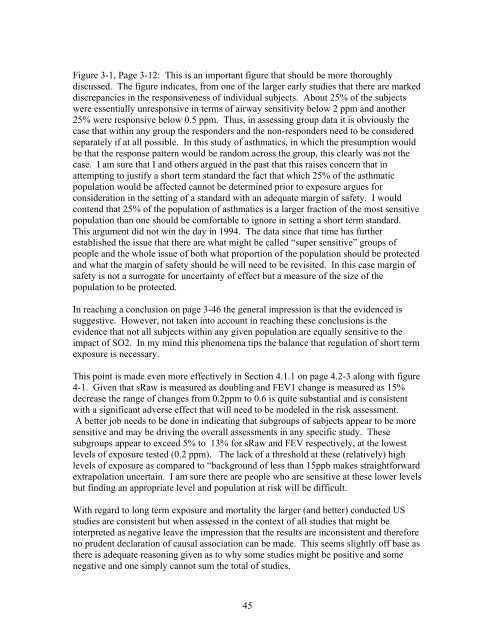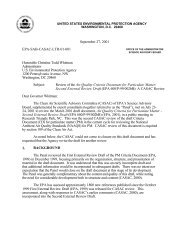(CASAC) Peer Review of EPA's Integrated Science Assessment
(CASAC) Peer Review of EPA's Integrated Science Assessment
(CASAC) Peer Review of EPA's Integrated Science Assessment
Create successful ePaper yourself
Turn your PDF publications into a flip-book with our unique Google optimized e-Paper software.
Figure 3-1, Page 3-12: This is an important figure that should be more thoroughlydiscussed. The figure indicates, from one <strong>of</strong> the larger early studies that there are markeddiscrepancies in the responsiveness <strong>of</strong> individual subjects. About 25% <strong>of</strong> the subjectswere essentially unresponsive in terms <strong>of</strong> airway sensitivity below 2 ppm and another25% were responsive below 0.5 ppm. Thus, in assessing group data it is obviously thecase that within any group the responders and the non-responders need to be consideredseparately if at all possible. In this study <strong>of</strong> asthmatics, in which the presumption wouldbe that the response pattern would be random across the group, this clearly was not thecase. I am sure that I and others argued in the past that this raises concern that inattempting to justify a short term standard the fact that which 25% <strong>of</strong> the asthmaticpopulation would be affected cannot be determined prior to exposure argues forconsideration in the setting <strong>of</strong> a standard with an adequate margin <strong>of</strong> safety. I wouldcontend that 25% <strong>of</strong> the population <strong>of</strong> asthmatics is a larger fraction <strong>of</strong> the most sensitivepopulation than one should be comfortable to ignore in setting a short term standard.This argument did not win the day in 1994. The data since that time has furtherestablished the issue that there are what might be called “super sensitive” groups <strong>of</strong>people and the whole issue <strong>of</strong> both what proportion <strong>of</strong> the population should be protectedand what the margin <strong>of</strong> safety should be will need to be revisited. In this case margin <strong>of</strong>safety is not a surrogate for uncertainty <strong>of</strong> effect but a measure <strong>of</strong> the size <strong>of</strong> thepopulation to be protected.In reaching a conclusion on page 3-46 the general impression is that the evidenced issuggestive. However, not taken into account in reaching these conclusions is theevidence that not all subjects within any given population are equally sensitive to theimpact <strong>of</strong> SO2. In my mind this phenomena tips the balance that regulation <strong>of</strong> short termexposure is necessary.This point is made even more effectively in Section 4.1.1 on page 4.2-3 along with figure4-1. Given that sRaw is measured as doubling and FEV1 change is measured as 15%decrease the range <strong>of</strong> changes from 0.2ppm to 0.6 is quite substantial and is consistentwith a significant adverse effect that will need to be modeled in the risk assessment.A better job needs to be done in indicating that subgroups <strong>of</strong> subjects appear to be moresensitive and may be driving the overall assessments in any specific study. Thesesubgroups appear to exceed 5% to 13% for sRaw and FEV respectively, at the lowestlevels <strong>of</strong> exposure tested (0.2 ppm). The lack <strong>of</strong> a threshold at these (relatively) highlevels <strong>of</strong> exposure as compared to “background <strong>of</strong> less than 15ppb makes straightforwardextrapolation uncertain. I am sure there are people who are sensitive at these lower levelsbut finding an appropriate level and population at risk will be difficult.With regard to long term exposure and mortality the larger (and better) conducted USstudies are consistent but when assessed in the context <strong>of</strong> all studies that might beinterpreted as negative leave the impression that the results are inconsistent and thereforeno prudent declaration <strong>of</strong> causal association can be made. This seems slightly <strong>of</strong>f base asthere is adequate reasoning given as to why some studies might be positive and somenegative and one simply cannot sum the total <strong>of</strong> studies.45
















